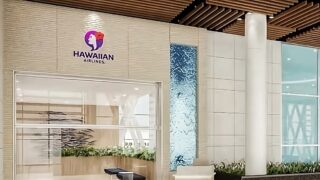For nearly a year, curious visitors at Honolulu Airport have had the chance to hop aboard Jetsons-like Beep autonomous electric shuttles—a glimpse into the potential future of airport transportation.
We were told by Beep that their 18-month pilot program will end in May, and the question that looms: Is this the end of the ride for these self-driving vehicles?
Meanwhile, new electric buses from Vicinity Motor Corp. are expanding their presence at the airport, potentially outshining Beep’s fleet, albeit less fascinating.


Beep’s autonomous shuttles: fast forward from innovation to obsolescence.
When Beep’s shuttles first rolled out at HNL, they offered a futuristic alternative to the Wiki Wiki Shuttle. Designed by Navya, a French company that pioneered autonomous vehicle technology, the shuttles promised to modernize inter-terminal transport while reducing the airport’s carbon footprint and providing a truly fascinating ride—all at the same time.
However, the reality has been less revolutionary than hoped. Navya has since filed for insolvency, and the vehicles—now eight years old—show signs of wear and tear both physically and technologically. Compounding the issue, the shuttles were never permitted to operate in their intended autonomous mode, requiring an onboard attendant at all times.
Editors Rob and Jeff rode the shuttle just yesterday, reporting that while the experience was enjoyable, the technology already felt dated. “It’s fun, but it’s clear these vehicles are nearing the end of their operational life,” Jeff noted.
We were at the airport when it wasn’t busy, and having the 11-passenger Beep do Wiki Wiki service between terminals felt much more energy-conscious than a large bus for the two of us.
New electric buses join the fleet.
While Beep’s program faces an uncertain future, HNL recently expanded its fleet of electric vehicles with the introduction of 18 Vicinity Lightning buses from Vicinity Motor Corp. These state-of-the-art buses were intended to replace traditional, noisy, and smelly diesel shuttles, providing a more sustainable and scalable solution for the airport’s 21 million annual passengers. It will, however, be arguably a lot less fun than Beep.
Manufactured at Vicinity’s Washington facility, these buses were part of Hawaii’s broader effort to transition to electric vehicles under the Electric Vehicles as a Service (EVaaS) program.
However, Vicinity Motor Corp., the manufacturer of the buses, recently entered receivership after failing to repay loans in excess of $22 million to the Royal Bank of Canada. The company has been delisted from NASDAQ, and its entire board and several senior management members have resigned.
These challenges are part of a broader struggle within electric vehicle manufacturing.
Companies like Lightning eMotors, Proterra, and Taiga have all faced bankruptcy within the past year. It remains unclear how Vicinity’s receivership will impact HNL’s new buses, particularly regarding ongoing maintenance and support.
Vicinity had previously touted a significant backlog of orders, with over 500 vehicles on the road in Canada and the U.S., but the current status of these commitments is uncertain. As the ripple effects of the company’s financial troubles spread, Export Development Canada (EDC), which guaranteed Vicinity’s debt, is also involved in the fallout.
For Honolulu Airport, this development raises questions about the long-term sustainability of its new electric bus fleet. While these vehicles represent a greener future, the challenges surrounding their manufacturer highlight the risks of relying on emerging technologies and companies.
What’s next for HNL?
With the Beep program nearing its conclusion, the Hawaii Department of Transportation must decide whether to find a new autonomous shuttle experiment or prioritize solutions like the Vicinity Lightning buses. While Beep’s shuttles offered an intriguing glimpse of the future, feedback has been mixed. Many travelers appreciated the novelty but found the shuttles too small and less practical than traditional options.
The addition of Vicinity’s electric buses suggests a shift toward proven and scalable technologies rather than experimental ones. One reader commented, “It’s great to see HNL going electric, but they need something that works reliably for the volume of passengers they handle.”
Balancing innovation with practicality.
Hawaii has been a testing ground for innovative Beep autonomous vehicle technology. The experimental program reflects the state’s willingness to embrace forward-thinking solutions, even if they don’t always stick financially or technologically. At the same time, the introduction of Vicinity Lightning buses highlights the importance of balancing innovation with operational needs.
As the contract with Beep approaches its May deadline, it’s clear that Honolulu Airport is moving toward a greener future. Whether autonomous shuttles remain part of the equation or are replaced entirely by electric buses, the airport is making strides in reducing its environmental impact.
Have you ridden one of Beep’s autonomous shuttles or the new electric buses at Honolulu Airport? If so, please share your thoughts in the comments below. And if you haven’t, now’s the time to get on board. We spoke with one of the Hawaii state agriculture employees stationed near the Beep shuttles. He admitted he hadn’t tried them yet, didn’t realize they would be leaving soon, and now plans to give them a ride.
Photo taken by Beat of Hawaii with our Beep attendant.
Get Breaking Hawaii Travel News







Yet another failed green experiment that most likely ended up wasting millions of dollars more rather than using regular transit. You Hawaiians really know how to pick your incompetent politicians.